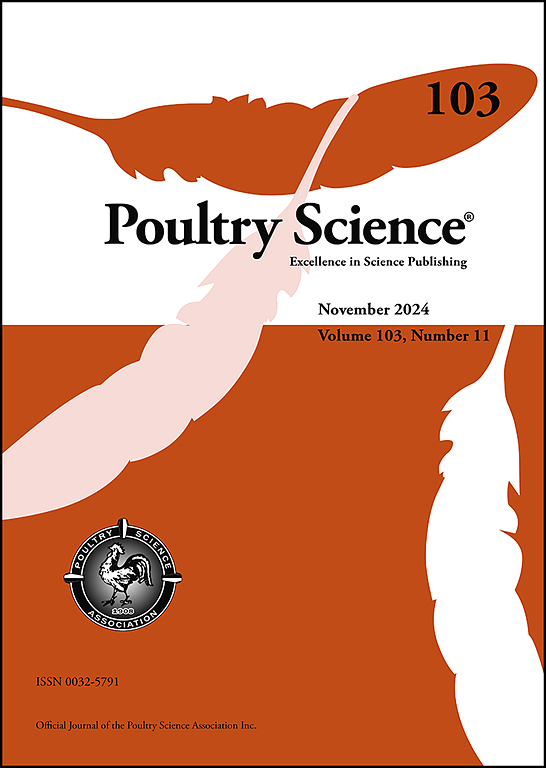铜和胆汁酸对蛋鸡蛋中胆固醇降低的协同作用
IF 3.8
1区 农林科学
Q1 AGRICULTURE, DAIRY & ANIMAL SCIENCE
引用次数: 0
摘要
本试验旨在研究铜(Cu)和胆汁酸(BA)对蛋鸡生产性能、脂质代谢和抗氧化能力的联合影响。试验为期67 d,选取160日龄精芬8蛋鸡300只,随机分为对照(基础饲粮)、铜(25 mg/kg Cu)、BA (500 mg/kg BA)和混合(25 mg/kg Cu和500 mg/kg BA的组合)4个处理组。结果表明,混合组显著降低了鸡蛋胆固醇水平,尤其是蛋黄胆固醇含量,同时提高了总抗氧化能力。此外,肝脏胆固醇代谢通过上调CYP7A1和ABCG5,下调SREBP-2和HMGCR来调节。虽然Cu和BA单独对产量的影响很小,但它们的组合对脂质代谢和抗氧化防御有协同影响。然而,Mix组肝脏锌含量降低,提示Cu和Zn之间存在拮抗关系。综上所述,饲粮中添加Cu和BA可以改善蛋鸡的蛋品质和代谢健康,同时也强调了在家禽饲粮中保持平衡的微量元素比例的重要性。本文章由计算机程序翻译,如有差异,请以英文原文为准。
Synergistic effects of copper and bile acids on cholesterol reduction in eggs of laying hens
This study investigates the combined effects of copper (Cu) and bile acids (BA) on production performance, lipid metabolism, and antioxidant capacity in laying hens. During a 67-day trial, a total of 300 Jingfen 8 laying hens aged 160 days were randomly allocated into four treatment groups: Control (basal diet), Cu (25 mg/kg Cu), BA (500 mg/kg BA), and Mix (a combination of 25 mg/kg Cu and 500 mg/kg BA). The results indicated that the Mix group experienced a significant decrease in egg cholesterol levels, particularly in the yolk cholesterol content, along with an enhancement in the total antioxidant capacity. Additionally, the liver cholesterol metabolism was modulated by upregulation of CYP7A1 and ABCG5, alongside downregulation of SREBP-2 and HMGCR. While Cu and BA individually showed minimal effects on production, their combination yielded a synergistic impact on lipid metabolism and antioxidant defense. However, the Mix group showed reduced liver zinc content, suggesting a Antagonistic relationship between Cu and Zn. These findings suggest that Cu and BA supplementation may enhance egg quality and metabolic health in laying hens, highlighting the importance of maintaining balanced trace element ratios in poultry diets.
求助全文
通过发布文献求助,成功后即可免费获取论文全文。
去求助
来源期刊

Poultry Science
农林科学-奶制品与动物科学
CiteScore
7.60
自引率
15.90%
发文量
0
审稿时长
94 days
期刊介绍:
First self-published in 1921, Poultry Science is an internationally renowned monthly journal, known as the authoritative source for a broad range of poultry information and high-caliber research. The journal plays a pivotal role in the dissemination of preeminent poultry-related knowledge across all disciplines. As of January 2020, Poultry Science will become an Open Access journal with no subscription charges, meaning authors who publish here can make their research immediately, permanently, and freely accessible worldwide while retaining copyright to their work. Papers submitted for publication after October 1, 2019 will be published as Open Access papers.
An international journal, Poultry Science publishes original papers, research notes, symposium papers, and reviews of basic science as applied to poultry. This authoritative source of poultry information is consistently ranked by ISI Impact Factor as one of the top 10 agriculture, dairy and animal science journals to deliver high-caliber research. Currently it is the highest-ranked (by Impact Factor and Eigenfactor) journal dedicated to publishing poultry research. Subject areas include breeding, genetics, education, production, management, environment, health, behavior, welfare, immunology, molecular biology, metabolism, nutrition, physiology, reproduction, processing, and products.
 求助内容:
求助内容: 应助结果提醒方式:
应助结果提醒方式:


